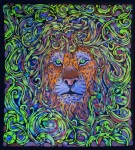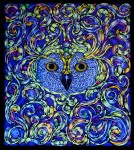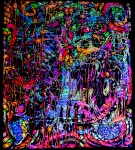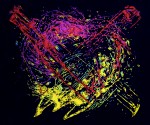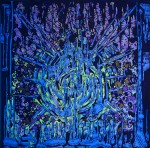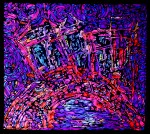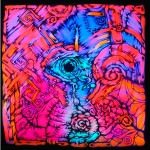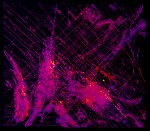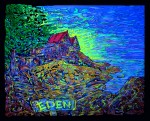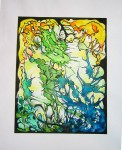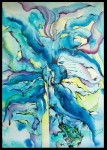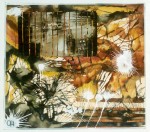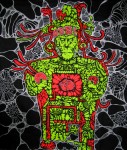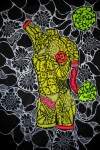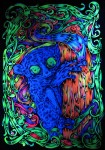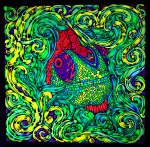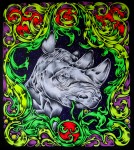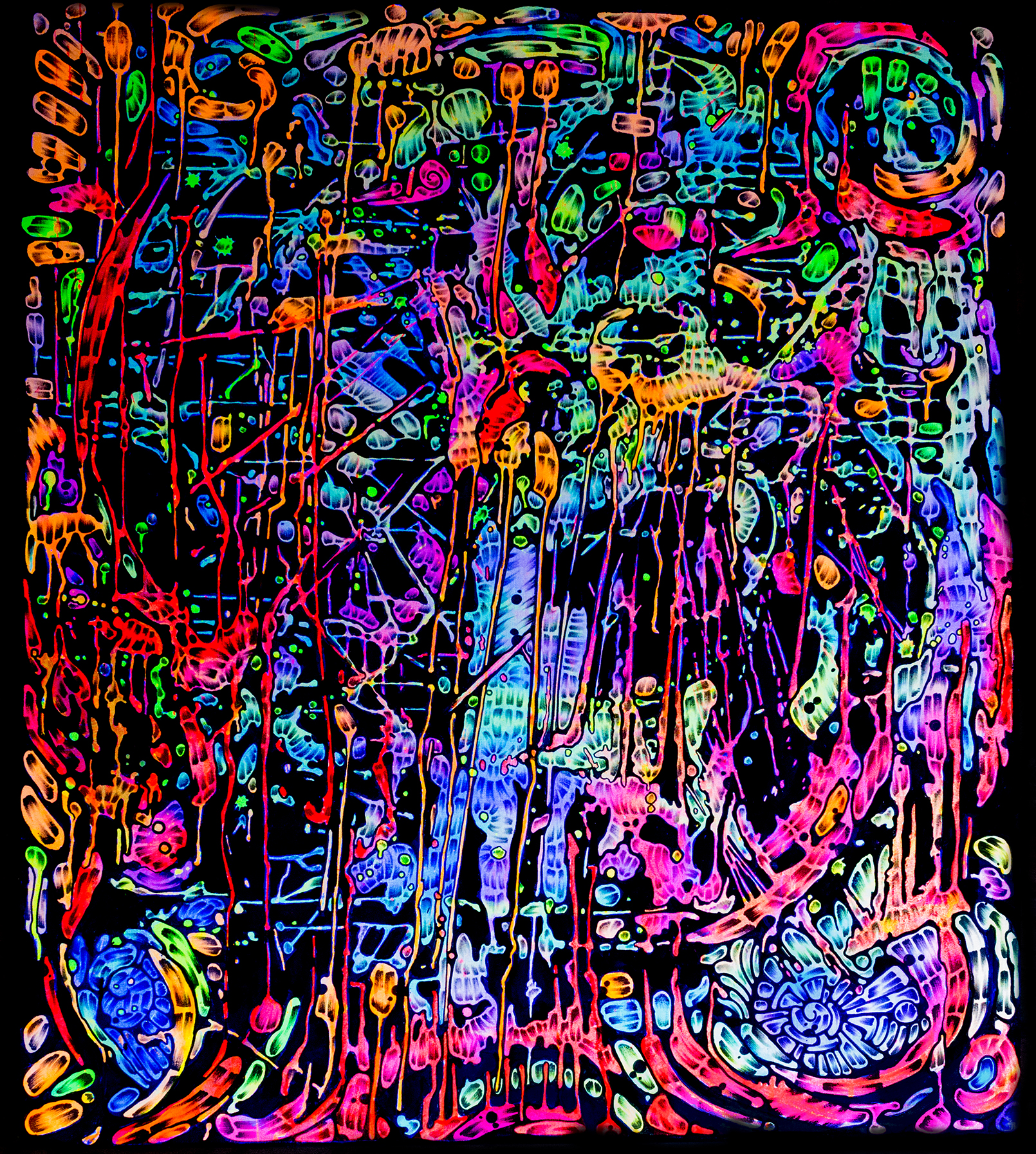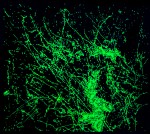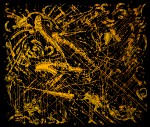Fluor, what is it? Perhaps, most people know just stickers or the t-shirts with a luminous print, the ones which sometimes may be come across in railway kiosks. Nightlife lovers can imagine club decorations at trans-parties. Art critics, at the word "fluor", would surprisingly shrug their shoulders…
We are talking with a Moscow artist Dmitry Abrosimov (aka Dimson) about fluorescent painting, and how such unusual creative work can be a real art.
The usual autumn day. Gloomy sky and bare tree branches behind the window. Dmitry Abrosimov aka Dimson by the gesture of a magician changes the lighting for ultraviolet and draws black-out curtains together. Three, two, one - I enter the room and get lost in the cosmic space. I've already seen all these works in the pictures, but I couldn't even imagine that they are so stunning in the original! The darkness is penetrated with bright spots and lines, as if they are pulsating, enveloping the viewer.
This is a magical gaze of a green-eyed lion - he seems to look right through you. Firemane goes beyond the canvas, interweaves with the frame and dissolves in the air.
On the opposite wall, completely abstract lines perform a crazy dance. Bright splashes and expressive paint streaks come together and form the picture somewhere in the labyrinth of my brain – whether the bones, or stickjaw, or tree branches.
The pictures hypnotize by their multidimensionality and mysterious movement. Suddenly the music begins. It fully merges with them, as if it consists of not the sounds but of flying colored droplets ... That is how fluorescent painting burst in my life for the first time.
A bit of history.
He has always been attracted to art: as a child he watched in fascination how his father (an artist) worked. He began the experiments with colors and spontaneous painting at the age of 14, being the pupil of the Arts and Crafts College. Dmitry remembers his first creative discovery:
"I was spilling paint and blowing on it through tubes. The blots of an interesting shape were obtained. The first picture, painted in this technique, represented a man and a woman. One blot is a splash of negative emotions, which are symmetrically reflected in the head of the second character. Against black-and-white background bright expressive red blots looked very spectacular."
Even then the artist was interested in the possibility to combine painting and graphics, "spontaneous art" and its rational design:
"I liked to watch as the color appeared during paint mixing. I worked under the classical scheme, that is, took watercolor paper, wetted it, sprayed paint, let it drain and stir. Later I added graphics. Using colored pencils, I emphasized the depth of interesting parts of the picture. I began to see in them something that cannot be drawn intentionally, the shapes that cannot be imagined purposely. I started making play with a spontaneously obtained result."
If you peer at Dmitry's works - from junior albums to the last cycle of paintings - everywhere you will notice a spiral motif. This may be a small shell in the very corner, or a spiral may be located in the center of the canvas, hidden by other elements. It appears that it's not just a decorative element, but the entire philosophy ...
"Spiral is a symbol of universal harmony, life and development. This solar sign, known to ancient peoples all over the world, is associated with the winter solstice - the sacred New Year, the starting point of cosmic cycles. It includes the ideal proportions of the golden section, which is sought by all living things. It made me fascinated when I was 14, and since then it's been a part of all my creative work."
* * *
Artifex: Why do you like Fluor?
D.A.: Regardless of fashion, for me this is an interesting and modern material. Due to the game with lighting, the process of creating a painting looks like a mystical action. It attracts the public. First, I paint without ultraviolet, then I add it, and the picture opens up in a new way. I always wonder myself, what will be when I complete my work.
Artifex: How did you get familiar with a fluorescent paint for the first time?
D.A.: Once, my friend gave me a small acrylic paints set of 6 colors. These were the remains of fluor, with which he drew something at home. I started trying, experimenting, and realized that traditional painting on black canvas is not an option for me. As bright inhabitants of a deep sea become gray, if you get them out of water, so this paint always looks rather sad, and begins to "play" only under certain lighting conditions. That's when I came up with the idea to use a canvas color as an additional source of light. This is the principal point. I paint all my pictures on a white cotton that fluoresce under ultraviolet light.
Artifex: Nobody else do this, right? Do all other artists paint on black?
D.A.: Yes, they do. The point is that the fluorescence painting is associated with trans-culture. The artists, related to it, use fluor for conveying volume and space on a black canvas. I do try to achieve the opposite effect. I need the fabric itself to be bright. The distinguishing feature of my works is that they shine very brightly. When I add graphics, the images become very fractional and contrasting. Without graphics my "chameleon" would remain just a color spot. In the black frame each brushstroke becomes individual and bright.
Artifex: Why is it more interesting to view your paintings to the music?
D.A.: In contrast to the classical art, when you come to the museum and speak in a whisper in order not to distract anybody, my works are better to be viewed with "immersive" tune. I paint and show them to the same music. This is a deep ambient. I consider it is an essential part of my work. When people hear the tune to which I painted, it intensifies perception and helps to feel those emotions which I put into my work.
Artifex: How would you describe the evolution of your creative work?
D.A.: The first series of my work contain the echoes of Hans Rudi Giger style. I made play with an academic drawing of a male and a female body, transforming them into biomechanoids.
Then brutal graphics took place. When I became interested in color and worked on the series "Totem Animals", my paintings started having something in common with a more fragile modern styling. The composition includes the main element, and it is fleshed out by the ornamental frame - something similar can be found in Alphonse Mucha's works. My spirals and strokes began to move from the center to the edges, merging into a kind of frames. First, they were as a framing, emphasizing the center. Then, they passed into the background, merging with the characters. The latter got cramped, yet at the same time they were well camouflaged. This way I managed to convey the interaction of animals with the natural environment. The chameleon is peeping out of leaves, merging with it, interweaving with an ornament. The lion, thanks to his color, is also dissolved in the landscape. In the picture his mane relates to the outside world and the stylized frame.
Artifex: Why are your animals "totemic"?
D.A.: I gave this name to my series to emphasize the symbolic importance of these images. Animal symbols are present in all traditional cultures. For example, the rhinoceros, according to feng shui, is the hearth keeper. The chameleon symbolizes flexibility and the ability to adapt to any conditions. The lion represents warmth and energy of the midday sun…
Artifex: Lots of your paintings are inspired by the impressions of traveling. In Finland you painted something like ice, in the Netherlands – something like bridges…
D.A.: Splashes of paints convey my emotions. I realized that while traveling I work better. During my first visit to Finland I tried snowboarding. I was not very good at this. Having got a slight concussion, I had to spend a few days alone, and at this moment the picture was born. It represents the sunset, seen through a broken piece of ice. This canvas features very harsh and sharp lines, it feels like a kind of destruction. This is probably because for me it was a hard trip.
During my second trip to Amsterdam we spent two weeks in the city center. I was admiring the ancient architecture, the houses, so different from each other; I was walking through the smooth stone-block pavement, looking at beautiful canals, which reflected the lights of the houses… Add to this the trips to various museums, in particular, a visit to the Van Gogh Museum. Van Gogh's sky inspired me! The channels, pavement, houses are visible in my picture, however, I didn't want to depict everything literally. It was the expression, caused by the impression, which developed into a fantastic landscape, inspired by Holland.
Artifex: All your paintings are very large. Is it because being a young man you were doing graffiti?
D.A.: By education I am a specialist in a lacquer miniature. Strange, isn't it? I've been engaged in graffiti since 14 years old. I used to work with small formats, yet I've always been drawn to the large. In order to re-create at home the feeling of the street, I took a huge board, nailed it to the wall and painted graffiti in my room!
Artifex: How do you find a way out while travelling? Not always there is a possibility to nail a board to the hotel wall, right?
D.A.: Yes, for example, during my first long journey through Asia the conditions did not allow to attach the canvas to the wall or build some kind of studio. In the construction market I found a half meter board of thick plywood, brought it to my terrace and began to paint. It was so uncomfortably to crawl near it to paint the bottom, the top ... And I began to turn this board! At this moment the topic of water-color streaks returned with some echoes. I let the paints spread, mix ...This transformed into something new. I started working in a three-dimensional space. Like Jackson Pollock, I put the canvas on the floor, turned it, placed vertically ... And the new style was born. I began to create unusual abstract paintings.
Artifex: Many of your pictures are painted on Phangan. How is this place reflected in your paintings?
D.A.: On the one hand, the island is a huge party and a constant expression: bright clothes, discos, fireworks, lasers. In my works they turn into splashes of paint, bright colors, and abstraction. One of my works, which I created there, is called "The Tree". The real tree became the inspiration, it is more than 500 years old and it is sacred on the Island. By its ancient power it balances such two incompatible things as a never-ending party and meditation. The other side of life on the Island is yoga and Buddhist centers. Therefore, one corner of the picture shows "Buddha's Palm", and the other one represents the galaxy, twisted into a spiral.
Artifex: Did you start painting the pictures during your journeys after the trip to the Island?
D.A.: Yes, having returned from there, I realized that no longer I want to deal with commercial orders and decorate interiors. Then I began to travel a lot and tried to convey in my paintings the atmosphere of different cities and countries. But all my thoughts were still about the Island, because that's where I worked particularly productively. In addition, so many foreigners live there, and they really respect my new technique. Six months later I returned and immediately started working on the new series. At the third month of my life on the Island I came to the new style. The works, made in one color, look more interesting…
Artifex: Why?
D.A.: It is a clear composition which can be traced by eyes. The color does not distract from the contemplation of the form.
Artifex: What is the process of working on painting?
D.A.: The work on my paintings is always divided into four stages. First, it is the expression on the white, spraying paint on a canvas. Then, drawing a contour by which I reveal the objects outlines. And only after this I fill empty spaces with deep black "background" that adds a sense of depth. And finally, these are graphic pictures over the color. They give third dimension to brushstrokes and a clear shape to drops. Each detail on the canvas is thought out and not occasional.
Artifex: My favorite picture in your new series is an abstraction which looks like a heart. Red and yellow expression with two lines, similar to arrows…
D.A.: Thank you. Somehow, all the girls see just a heart in this picture. Actually, I did not paint it. For me, it's Tom Yam, Thai soup with spices! Look at it more closely: this thing is similar to a shrimp, and this one is an ant or a grasshopper. And the lines, which you associate with the arrows, are actually spices flying to a large bowl, where a traditional Thai soup is swirled.
Artifex: It is unexpectedly! And why just soup?
D.A.: I wanted the picture to convey the atmosphere of the place where I painted it. Thai cuisine is primarily seafood, and for exotic the tourists are ready to eat even different beetles. All this is depicted on my canvas.
Artifex: That's interesting. I, as a woman, would never think that it is soup! For me your picture will always be a symbol of love: all these sentiments are painted in pink, and passion, broken heart and destruction are painted in red. I think you depicted the whole range of love emotions: tenderness, chaos, affection, knives, a clash with the ego ... Maybe I perceive your new triptych also incorrectly?
D.A.: The three parts of the triptych symbolize birth, life and death. Green picture is more flexible, it represents birth, as we all came out of water. Red one is our reality which is severe, harsh and aggressive. And the third picture, the yellow one, bends us to the ground, reminds us of the bones and the remains, it symbolizes the ashes.
Artifex: Recently, several your exhibitions have taken place. One of them is a joint project with our almanac…
D.A.: When I came back from the first trip to Asia, my friend Sergei Zitron offered me to arrange the exhibition at "Trimurti 2014". This summer at "Trimurti 2015", with the support of Artifex, we organized a big gallery, where I showed 23 pictures.
Artifex: You had a gallery on the Island as well…
D.A.: When I lived on the Island for the second time, I rented the premise which was ideal for my paintings. There was as much space as I needed for the works which I managed to create within three months. That was an empty room on the main road. I furnished it with traditional Thai poufs. As a result, there appeared exactly the atmosphere which I was lacking in Moscow galleries.
Artifex: You excellently possess academic technique. So, could you easily draw usual landscapes, girls, kittens and the like?
D.A.: People often do not understand why the artists, who can do it, spray paints and paint abstract pictures... Because any abstraction contains a hidden depth. And I would like people to think. Everyone can look at the picture in his own way, without being attached to any form. I give the viewer an opportunity to see in my pictures what he likes. Someone looks at the picture as a whole, someone pays attention to small details. These pictures must be studied, they cannot be viewed within five minutes. In order to assess how the smear spread, how one color transfers into another, you need to spend at least 20-30 minutes. If you take them seriously, you can experience deep emotions.
Artifex: Many people don't take Fluor seriously, why?
D.A.: I think, it is because usually they come across this art in the form of psychedelic drawings at the scenes of trans-parties. For this reason people react the way like: "Fluor, so these are decorations…"
Artifex: Would you like to bring Fluor to a more serious level?
D.A.: Yes. Fluor is just a material of the XXI century. Luminous paints is the same advanced technology as video installations and mapping. You can paint with flour as well as with oil. I've worked with it for 14 years and tried it in different styles. It deserves to be presented in art galleries and serious museums. Any direction in the art gains recognition sooner or later. Recall that the impressionists were attacked, but during the lifetime the attitude towards them changed dramatically, and they began to be considered almost as classics. The same situation is with Fluor. I believe that a dark hall should be in every museum!
Artifex: Thank you for the interview! I hope we will arrange a lot of exhibitions together! Good luck in your creative works, we will wait for your new pictures!

